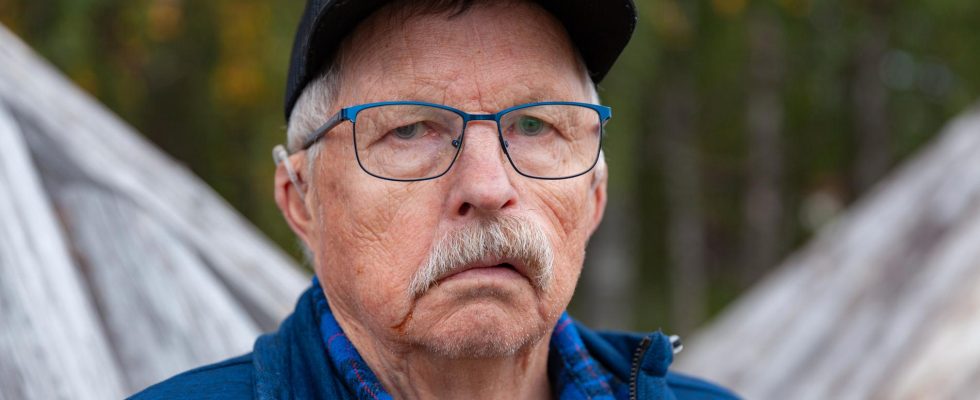1 / 3Photo: Anders Vestin/TT
Mental abuse. A constant worry of being forced out of their home. Now Lars Stenberg, 76, is testifying before the Truth Commission for the Sami people about how the state affected his life.
– We weren’t worth a rotten penny, he says.
As a child, he was forced to attend a nomadic school eight miles away from home. At the age of seven, he only got to see his family at Easter, Christmas and summer holidays.
– I thought I would get rid of the feelings. But what I was exposed to has haunted me my whole life, he says.
At school he was subjected to mental abuse, which was based on the fact that he was a forest Sami, and not a mountain Sami. He was told that the meat from their reindeer was inedible, he was forced to speak Swedish and was told that his native Umesami language was only rappakalja. Even the master spoke ill of the Forest Sami in front of the whole class.
At home there was constant worry. His father and ancestors had had reindeer on the lands for as long as they could remember, but according to a section of the Reindeer Grazing Act from 1928, forest Sami risked having to give way to settlers or mountain Sami.
– My father was scared. Nobody knew what would trigger the paragraph, says Lars Stenberg.
Politics that divide
The Reindeer Grazing Act was a way for the state to limit how many Sámi had the right to let the reindeer graze, as well as hunt and fish in the north, according to the Sámi Parliament’s preliminary study. It then paved the way for the state investigation, the Truth Commission for the Sami people, which is currently being carried out in the country.
The Reindeer Herding Act was also connected with the “patch should be a patch” policy – a policy that divides the Sámi to this day. It consisted of distinguishing different Sami groups from each other, where the mountain Sami were considered “authentic”, while the forest Sami and others who did not live a nomadic life or had reindeer were to be Swedishized.
They lost the right to let reindeer graze and to hunt and fish on the land that many claim they have had since time immemorial.
Oppression of the mountain sámi
Forest Sámi were discriminated against through the Reindeer Grazing Act, but mountain Sámi were instead victimized in other ways. As nomads, they were considered the lowest in human development. They were to be kept away from the majority society by putting the children in nomadic schools where they received a poorer education and were punished if they spoke their mother tongue, sometimes with beatings.
Many Fjällsami also lost their reindeer grazing land when the borders between the countries on the North Calotte were closed approximately 100 years ago. When the reindeer could no longer wander between the Norwegian and Swedish sides, the state forcibly relocated the reindeer and the Sami to other areas. On the other hand, there were other Sámi who now got less land for their reindeer – a conflict that lives on in many places to this day, including in Västerbotten.
There are also examples of how the Sami have been tricked into leasing the land instead of getting ownership contracts.
Lars Stenberg draws parallels to the indigenous population of America. The theft from the Sami continues to this day with the exploitation in the north, he believes. In addition, the climate crisis is devastating.
– It feels like we should have no place. It’s not a fun time, that’s the harsh truth.
Until February next year, anyone who wants to leave their story can report this to the Truth Commission for the Sami people. The investigation must be fully completed by 1 December 2025.
THE FACTS The Sami people – the only indigenous people in Europe
As an indigenous people, the Sami have the right to self-determination, something that has been established, among other things, by the UN Human Rights Committee.
Sweden has been criticized for not always following the UN’s declaration of indigenous peoples, and for not having ratified ILO 169, which would give the Sami more power over the reindeer pastures than they have today.
The area where the Sámi originally lived – Sápmi – stretches across northern Sweden, Norway, Finland and the Koala Peninsula in Russia.
How many Sámi there are in Sweden is unclear, because the census is not carried out on an ethnic basis. But the Sami Parliament estimates that there are 20,000 to 40,000 Sami in the country.
However, there are many more with a Sami accent, some of whom identify as Sami.
In order to vote in the Sami Parliament, you must have Sami as a language at home, or that one of the parents or grandparents has or has had Sami as a language at home.
Source: The Truth Commission for the Sami People and the United Nations
Read more
